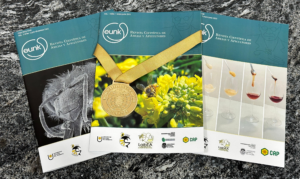

Varroosis: control methods after harvesting.
Jar method.
The end of harvesting means a new step in the life of a beekeeper: the healing period. It’s very important to know when and how to do it.
The end of the season is a period where controlling the health of our hives is very important. Varroosis is a desease that attacks the larvae feeding from body fat, reducing the levels of body protein. When fall comes, health and nutrition must be considered to secure the demand of our hives to survive the cold temperatures is covered.
Recommendations
To prevent any kind of inconvenient, the CAP recommends to take action to control the health of our hives:
- Take samples that show us how infested the hive is by using methods like the jar method, that we’ll be explaining later on this same article.
- Apply acaricide products. It’s better to use approved and with high efficiency products.
JAR METHOD
WHAT IS IT?
The jar method is the only way to get the infestation percentage in the apiary in a fast and simple way.
It consists in taking multiple samples from the breeding chambers. The number of samples depends on the number of hives: if the number of hives in an apiary is less than 60, it’s necessary to take at least 6 samples; if it’s more than 60, the number of samples should be the 10% of the total in order to get the highest representativity possible.





HOW TO DO IT?
- Pour alcohol in a wide mouth mason jar. It’s also possible to use water and detergent.
NOTICE: it’s important to identify the jar if we have more than one apiary, in order not to mix samples. - Move the jar downwards on both sides of three frames from the breeding chamber. Approximately between 200 and 300 bees will be trapped in the jar.
NOTICE: before doing this step, check if the queen is not on the frames where the samples are taken. - Once the sample taking has ended, shake the jar for 5 minutes. This way, bees and varroas wil be separated.
- Pour the content of the jar to another with a sieve in the middle, in order to retain the bees and varroas.
- Count the bees and the varroas. Then calculate the infestation percentage through this formula:
(Mites / Bees) * 100= Infestation percentage.
WHEN SHOULD I TAKE THE SAMPLES?
We mustn’t forget the objective of keeping our hives healthy. Therefore, we should ask ourselves:
Why should we take samples? Why should we treat the hive?
The sampling should be thought as part of the treating process and must be performed at the end of the harvesting season. Treatment without knowing the mites load can’t ensure that the treatment will control them. Let’s suppose our levels are higher than 30%; we’ll need 2 treatment periods to control the varroosis.
If we don’t take accountability about our current hive health that could lead to think that the treatment didn’t work. But reality shows that without a previous element of comparison, we won’t know the efficacy nor be sure the hive is healthy.





Dejar un comentario
¿Quieres unirte a la conversación?Siéntete libre de contribuir